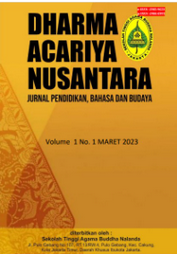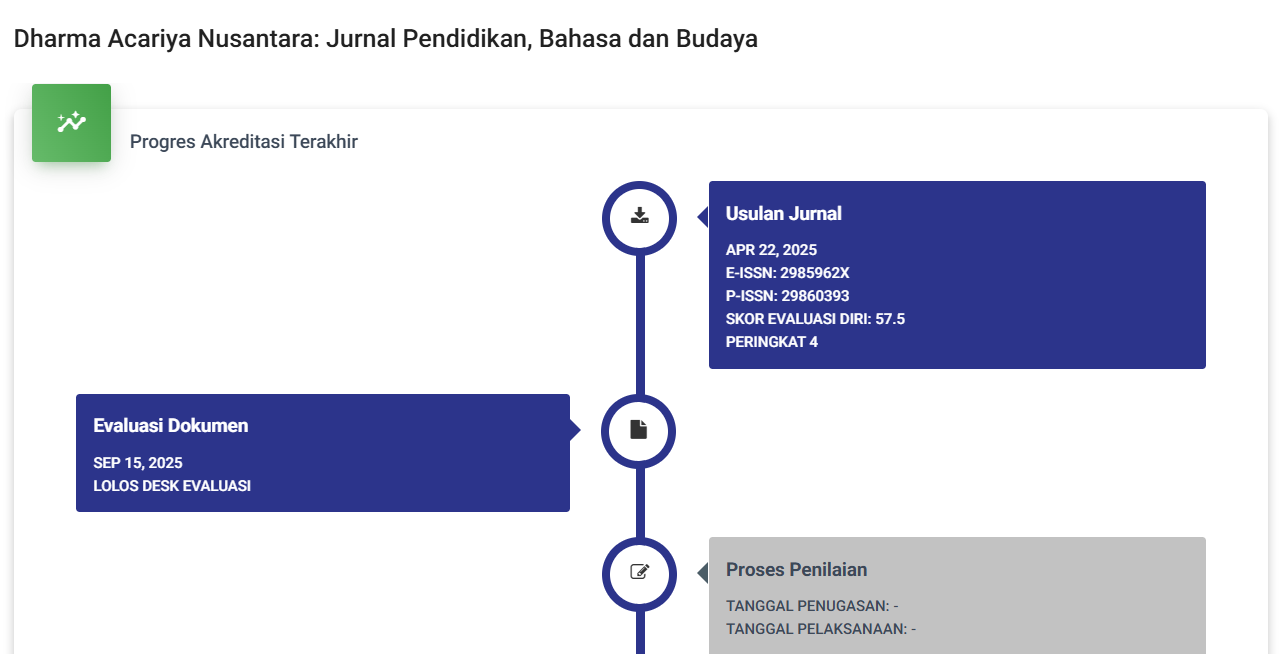Analysis of The Duai Boe Traditional Ceremony of Bajo Tribe In Parumaan Village
DOI:
https://doi.org/10.47861/jdan.v2i1.800Keywords:
Semiotic, Duai Boe traditional Ceremony, Bajo TribeAbstract
This research aims to describe the process in the Duai Boe traditional ceremony and analyze the meaning of the symbols used in the Duai Boe traditional ceremony. The researcher used qualitative method. Data collection techniques used in this research are interview and documentation. The results of the research found that there are two stages of the Duai Boe traditional ceremony. The first stages is called Bantang and the second stage is called Paduwai Atowene Ka Boe Tella which is the final stage of Duai Boe traditional ceremony. There are eight symbols used in the Duai Boe traditional ceremony, namely 1) The coconut water symbolizes that in the future the baby can be useful for many people, 2) The rice symbolizes that the mother has performed the Duai Boe ceremony, 3) The ring symbolizes a hope that this child will be attractive like gold, 4) the thread tied around the baby's wrist symbolizes that this baby does not get sick, such as wounds or redness on the wrists, feet, elbows, groin, stomach and neck, 5) money symbolizes as a family thank you to the Sandro for the assistance provided from the beginning of childbirth until the ritual ceremony is complete, 6) knife blade stuck in a cloth has been burnt symbolizes that spirits don't approach and disturb the baby's mother because spirits don't like the smell of burning cloth, 7) The Incense symbolizes calling the spirits of the ancestors to come witness the ritual and are expected to pray for the baby so that what the family hopes for in the future will be achieved.
References
Alam M. Nur. (2016). Simbol dalam Kenre Jawana Mangkasarak Skripsi tidak di terbitkan Universitas Muhammadiyah Makassar
Arikunto S. (2013). Research Precedures A Practical Approach.Revised edision. Jakarta. PT. Rinekacipta.
Ati, S. (2018).Oral tradition of KololiKie as a cultural learning resource for the Island Ternate community.ISLLAC: Journal of Intensive Studies on Language, Literature, Art, and Cultu re, 2(1), 71-74.
Azmi, U. (2023). Fase dan Makna Simbol Ritual Badudus dalam Novel" Lalu Tenggelam di Ujung Matamu": Kajian Antropologi Simbolik Victor Turner. SeBaSa, 6(1).
Baihaqi, M. (2021).Implementation of Multicultural Education in Indonesia. EDUTEC: Journal of Education and Technology, 4(3), 504-526.
Bismawati, A., Efendi, E., Halifah, N., &Trisnandemi, T. (2021, r).SYMBOLIC MEANING IN THE KAILI TRADITIONAL WEDDING SERVICE. In Prosiding Seminar NasionaldanInternasional HISKI (pp. 385-399).
Gorlée, D. L. (2022). Semiotics and the problem of translation: With special reference to the semiotics of Charles S. Peirce. Brill
Hartono, D., & Pelly, U. (2020,) Education of Character and Value in JamuSawah.In The 5th Annual International Seminar on Transformative Education and Educational Leadership (AISTEEL 2020) (pp. 70-72).Atlantis Press.
Hidayat, F. (2020).ON BUDAYA AND THE RE-SACRALIZATION OF INDONESIAN CULTURAL ANTHROPOLOGY. PrajñāVihāra: Journal of Philosophy and Religion, 21(2), 1-32.
Hafid, A., & Raodah, R. (2019). Makna Simbolik Tradisi Ritual Massorong Lopi-Lopi Oleh Masyarakat Mandar Di Tapango, Kabupaten Polman, Provinsi Sulawesi Barat. Walasuji, 10(1), 33-46.
Ihwani, R. B., & Bata, W. D. (2022),The Meaning Of Mantra in the Ritual Teing Hang Kolang In A Traditional Community Ceremony In Tangge Village, Lembor District, West Manggarai..
Mantang. (2018). Makna Simbol Dalam Perayaan Jepe Syura Sepuluh Muharram DI PulauBarrangLompoKecamatanSangkarang Kota Makassar ( Pendekatan Semiotik).Skripsi tidak di terbitkanUniversitas Mhammadiyah Makassar
Moleong L. (2010). Qualitative Research Methodology.Bandung :Adolescent Rosda Works. PT Teenagers Rosdakarya.
Nöth, W. (2015). Three paradigms of iconicity research in language and literature. Hiraga, Masako K.; Herlofsky, William J.; Shinohara, Kazuko, 13-43.
Pranata, J., Wijoyo, H., &Suharyant, A. (2021).Local Wisdom Values in the Pujawali Tradition.Budapest International Research and Critics Institute-Journal (BIRCI-Journal).
Rachman, A. H. (2021). Different perspectives in defining culture.Indonesian Journal of Social Sciences Volume, 13(02), 84-94.
Rosyad, R., Wahyudin, D., Hamim, M., Sonjaya, A., &Alam, A. S. (2020).Sacred Calendar and Expression of Religion in Indonesia.International Journal of Psychosocial Rehabilitation, 24(09)
Saleh, N. A. (2017). DINAMIKA PERAN SANDO MEANAQ DALAM UPACARA KELAHIRAN BAYI PADA MASYARAKAT MANDAR. Walasuji: Jurnal Sejarah dan Budaya, 8(2), 336-350.
Sholehuddin, M. S., Munjin, M., &Adinugraha, H. H. (2021).Islamic tradition and religious culture in halal tourism: empirical evidence from Indonesia. IBDA: JurnalKajian Islam Dan Budaya, 19(1), 79-100.
Sugiyono. (2018). Metode Penelitian Kuantitatif. Bandung: Alfabeta.
Swathy, I. D. A. I., Joni, I. D. A. S., & Suryawati, I. G. A. A. (2020). Makna Simbol Komunikasi Dalam Tari Topeng Sidakarya. Jurnal Ilmiah Mahasiswa Ilmu Komunikasi Medium, 1(1), 38-45.
Swidler, A. (2000). Cultural power and social movements. Culture and Politics: A Reader, 269-283.
Timbasz, G., Basyar, S., Yanti, F., & Basri, H. (2020, December). Preservation of The Begawi Abung Siwo Migo Tradition Development Oriented and Social Welfare in Lampung Multicultural Community. In Proceedings of The International Conference on Environmental and Technology of Law, Business and Education on Post Covid 19, ICETLAWBE 2020, 26 September 2020, Bandar Lampung, Indonesia.













